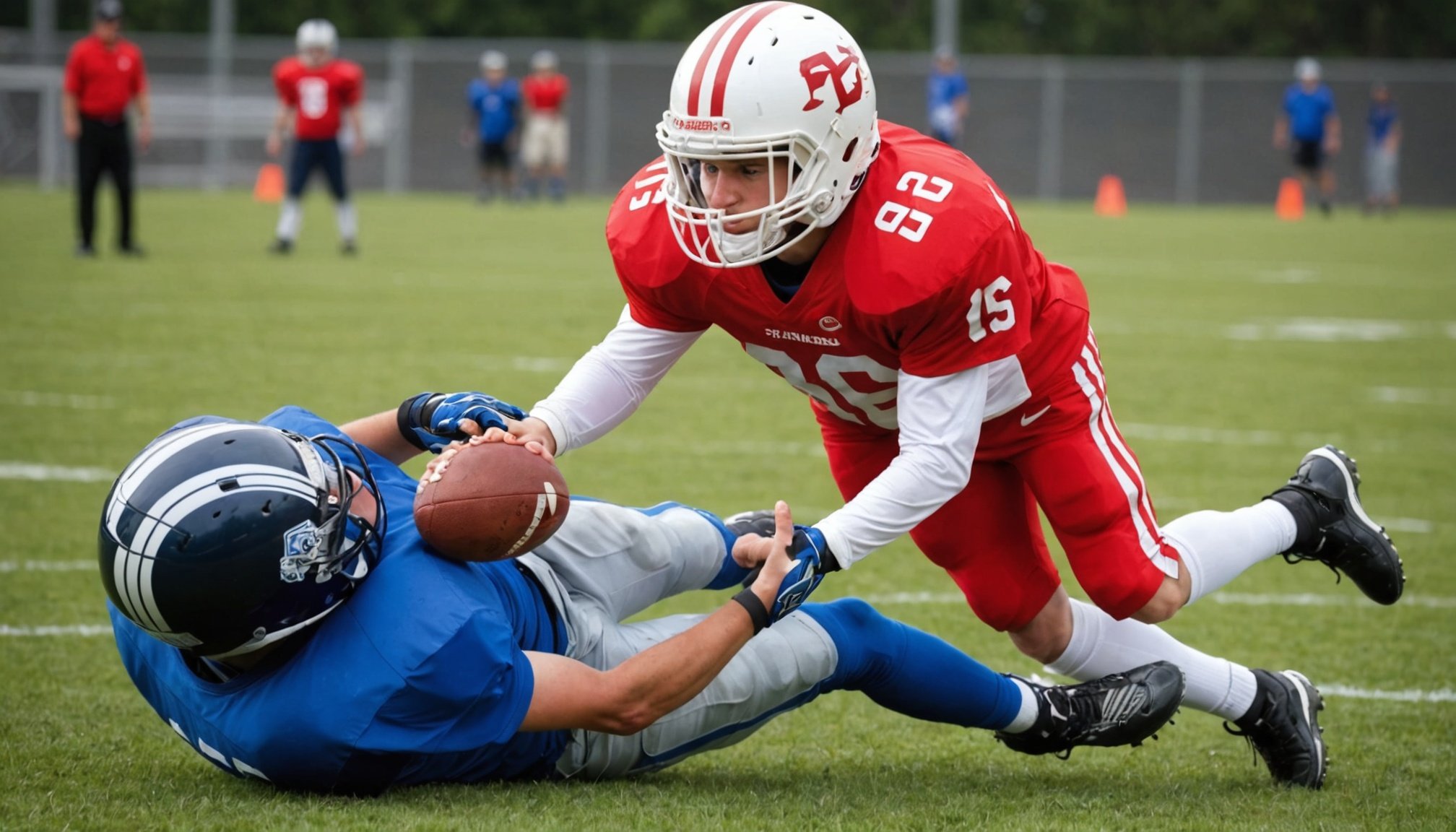Understanding Common Injuries in Youth Football
Youth football, while a cherished sport, is not without its challenges, particularly regarding player safety. Common youth football injuries range from minor bruises to more severe afflictions. Notably, sprains and strains frequently top the list, involving ligaments and muscles that endure significant stress during play. Concussions, though less frequent, pose serious long-term health concerns, necessitating immediate and careful attention.
Injury statistics highlight the need for vigilance. Data suggests that nearly 30% of youth football players experience an injury each season. This high rate underscores the importance of understanding injury statistics as a foundation for implementing effective prevention measures. By comprehending these figures, stakeholders can better strategize interventions.
Also read : Top Strategies for Football Academies to Enhance Technical Skills in Young Athletes
Prevention measures have proven to be game-changers. Regular training on proper tackling techniques, wearing appropriate protective gear, and ensuring sufficient recovery time between games are crucial steps. Emphasizing these practices can reduce injury rates significantly. Furthermore, regular education sessions for coaches, players, and parents on how to recognize symptoms of serious injuries like concussions can provide an added layer of protection. Thus, investing in knowledge and prevention strategies not only safeguards the athletes but also enriches their overall sporting experience.
Importance of Proper Training Techniques
In football, effective training is crucial for both injury prevention and enhancing skill development. Inadequate preparation can lead to unnecessary injuries, which ultimately affect a player’s performance and progression. Implementing safe practice strategies forms the backbone of efficient training, allowing athletes to hone their skills in a secure environment.
Have you seen this : Unlocking Athletic Potential: The Surprising Advantages of Adding Yoga to a Footballer”s Training Routine
The role of proper training techniques cannot be overstated when it comes to minimizing injuries. By adhering to well-structured drills, athletes learn to execute movements safely, understanding the limits of their bodies. This awareness reduces the chances of injuries during both practices and matches.
Focusing on skill development, exercises should improve reflexes, stamina, and game sense. Key components include targeted drills that enhance individual abilities, such as dribbling and passing accuracy. Adaptability to different play styles is also fostered through versatile training regimens.
Supervised training provides structured guidance, ensuring that activities are performed correctly and safely. Coaches can offer immediate feedback and tailor exercises to an athlete’s specific needs. In contrast, unsupervised training might lead to improper practices, potentially increasing the risk of injury. While autonomy helps players develop personal responsibility, it’s crucial to accompany such sessions with previously learned safe strategies.
Effective Warm-Up and Cool-Down Routines
Warm-up exercises are essential components of youth football training. These activities increase blood flow, enhance muscle elasticity, and prepare the body for intense physical exertion. Typical exercises include jogging, dynamic stretching, and mobility drills tailored to football. Dynamic stretches like leg swings and arm circles are particularly beneficial, as they mimic movements used during play, helping improve overall performance.
Cool-down routines are equally crucial for muscle recovery and injury prevention. They help the body transition from high activity to a resting state, which is paramount for reducing soreness and stiffness. Static stretching combined with activities such as light jogging or walking can significantly aid in this process. This practice helps eliminate waste products like lactic acid, thus contributing to faster recovery.
For optimal results, warm-up exercises should last between 15 to 20 minutes, allowing ample time for cardiovascular stimulation and muscle activation. Cool-down routines should be about 10 minutes, focusing on gradual heart rate reduction and extensive stretching. Consistently implementing these routines not only enhances performance but also builds a solid foundation for injury-free training. By embedding these practices, young athletes are poised to reap long-term benefits beyond the field.
Recommended Equipment and Safety Gear
In the high-contact sport of youth football, ensuring player safety is paramount. Key football equipment includes helmets and pads, crucial for protecting players from injuries. Helmets should have a snug fit, covering the head completely without shifting during movement. Equally important, the chin strap must be securely fastened. Regular checks for cracks or wear are advised, as damaged helmets compromise safety.
Protective gear extends beyond helmets. Shoulder pads, knee pads, and hip pads offer essential safeguarding against impacts. Shoulder pads should comfortably cover the shoulders while allowing freedom of movement. Like helmets, they require routine inspections to maintain integrity.
Youth football safety also involves paying attention to protective gear like mouthguards, which are vital for preventing dental injuries. Comfortable and fitted properly, mouthguards are an indispensable piece of gear for players.
Assessing equipment regularly is vital. Frequent equipment checks ensure all gear fits well and functions properly, reducing the risk of injury. Engage in proactive equipment maintenance and educate players about the importance of their gear. Through proper selection, maintenance, and assessment of football equipment, youth football players can enjoy the game safely.
Establishing Safety Protocols and Guidelines
Implementing safety protocols is crucial in the realm of sports to ensure player well-being. These protocols encompass a range of practices designed to mitigate the risk of injuries during both play and training sessions. Developing comprehensive safety guidelines requires a deep understanding of sport-specific risks and the appropriate measures to counter them.
Coach responsibilities are a pivotal component in the enforcement of these safety measures. Coaches must not only impart technical skills but also ensure that each player adheres to established safety guidelines. This includes regular checks on equipment, enforcing the use of protective gear, and supervising adherence to safe techniques during drills and games.
Parents also play an integral role. Engaging them in discussions around safety helps build a more robust support system for young athletes. Parents can encourage adherence to protocols outside of official practice sessions, enforcing learned behaviors that prevent injuries.
Communication and education are key in this regard. Regular workshops or briefings should be organized to keep both players and parents informed of the latest safety measures, including injury prevention techniques and emergency response procedures. This creates a proactive culture where safety is prioritized by all involved, ensuring everyone is aware of their role in maintaining a safe sporting environment.
Case Studies and Statistics on Injury Prevention
Exploring how injury prevention strategies work, especially in youth sports, can reveal significant insights. Several case studies have highlighted successful methods in reducing injuries in these environments.
For instance, a study conducted in youth football showcased the effectiveness of specific warm-up routines, resulting in a noticeable decrease in injury rates. By implementing structured warm-up exercises that focus on increasing flexibility and reinforcing muscular strength, schools recorded a reduction in sprains and strains among young athletes.
Research findings further strengthen these observations, showing that targeted injury prevention strategies not only curb injury incidents but also enhance performance overall. The study titled “Youth Sports Research: Injury Prevention Best Practices” emphasized how incorporating correct technique and safety gear plays a critical role in safeguarding young players.
Supporting these studies are statistical outcomes demonstrating that comprehensive injury prevention programs, when consistently applied, reduce injury rates by up to 30%. These findings suggest adopting these evidence-based strategies in training programs, thus ensuring safer youth sports involvement.
Recommendations based on these research insights include integrating multifaceted injury prevention protocols that blend physical conditioning, safety training, and player education. This holistic approach promises not only to safeguard young athletes but also foster their long-term athletic development.
Role of Coaches and Parents in Injury Prevention
Understanding the parents’ role and coaches’ responsibility is crucial in safeguarding young athletes. In youth sports, especially football, parental involvement is paramount. Parents must ensure their children are engaged in safe practices by advocating for comprehensive safety measures. This includes equipping children with appropriate gear and understanding the risks associated with the sport.
Coaches hold the responsibility to monitor the players’ safety and well-being actively. This includes overseeing training sessions to ensure they practice proper techniques to prevent injuries. Coaches must also be well-versed in recognizing early signs of potential injuries, enabling swift action to mitigate further harm. Youth sports advocacy highlights the necessity for coaches to update their knowledge on safety regulations and maintain open communication with both players and their parents.
Collaborative strategies between parents and coaches can significantly enhance safety practices. Regular meetings can be an effective platform for sharing insights on the players’ progress, discussing any concerns regarding player health, and reinforcing safety protocols. Joint educational sessions can help in spreading awareness about injury prevention strategies, further reinforcing the commitment to safeguarding the youth. Consistent engagement and transparent communication between parents and coaches are fundamental to creating a safer environment for young athletes in sports.











